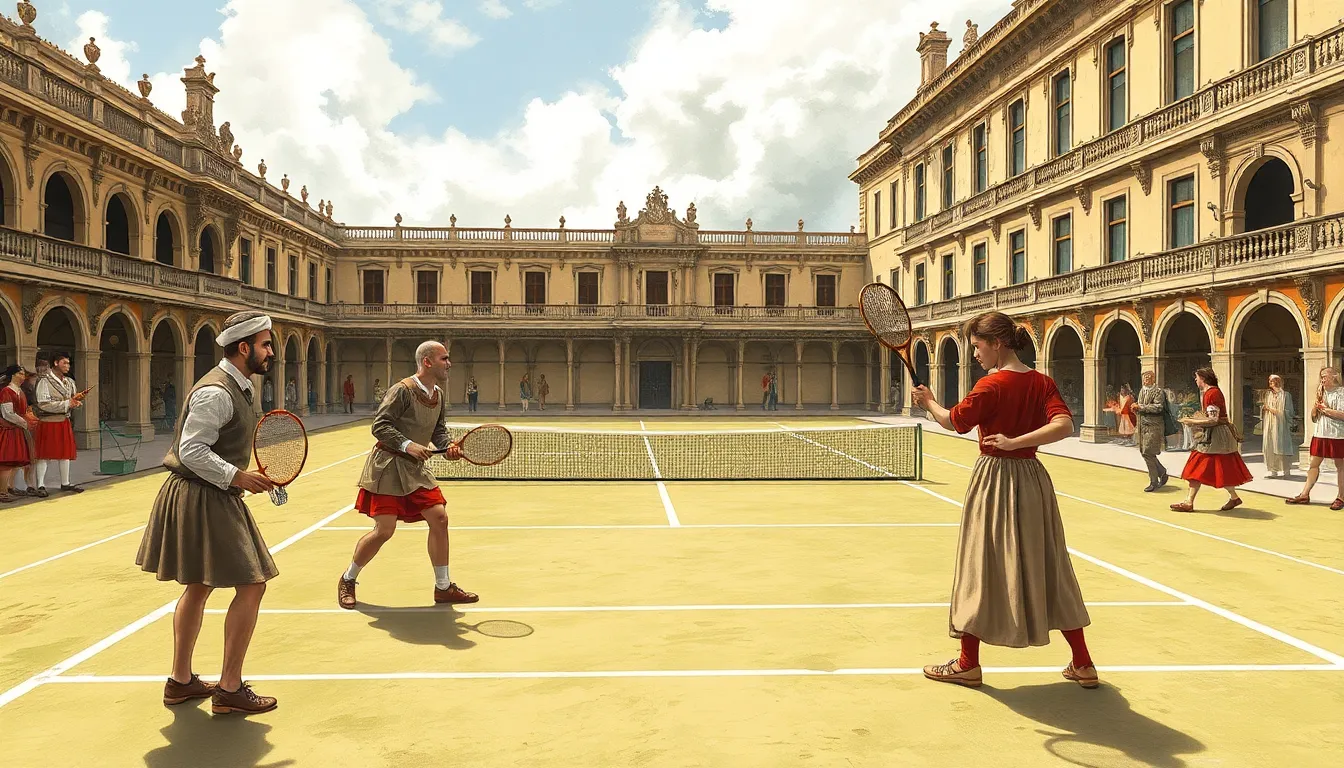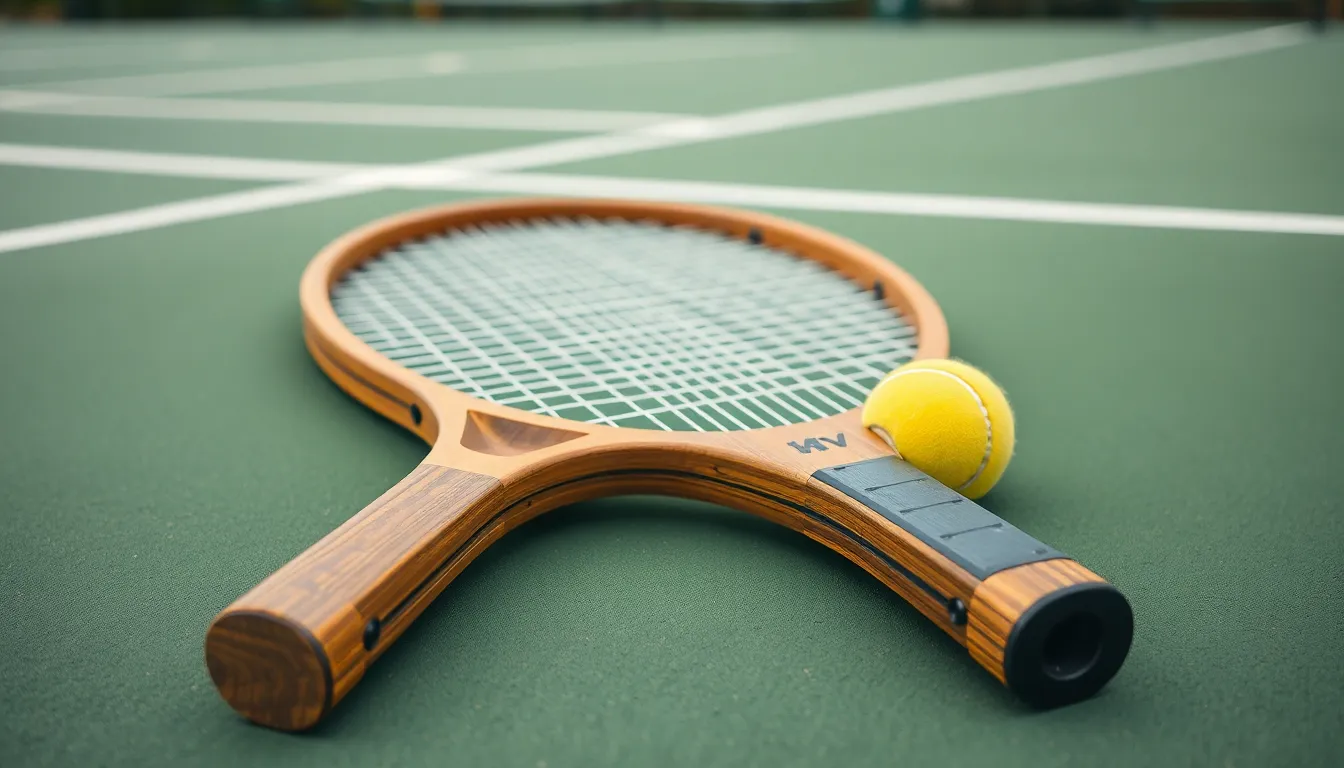Ever wondered why tennis scoring uses terms like “love,” “15,” “30,” and “40” instead of simple numbers? This peculiar counting system has puzzled newcomers and casual fans alike for generations. There’s actually fascinating history behind these seemingly arbitrary numbers.
Tennis scoring evolved from a medieval French game called “jeu de paume,” where players initially scored in increments of 15, representing quarter moves around a clock face. The term “love” likely comes from the French word “l’oeuf” (meaning egg), symbolizing zero’s oval shape. While these explanations shed some light on tennis’s unique scoring system, they’re just part of the rich tapestry that makes this sport so distinctive.
The Unusual Scoring System in Tennis
Tennis scoring stands out as one of the most peculiar counting systems in sports. When you’re watching a match, you’ll hear terms like “love,” “15,” “30,” “40,” and “deuce” instead of simple numbers like 0, 1, 2, and 3. This unconventional system often confuses newcomers to the sport.
I’ve spent countless hours explaining this scoring system to my students at the University of Florida. Many beginners give me puzzled looks when I first introduce these terms during coaching sessions. One of my students, Sarah, once joked that learning tennis scoring was harder than her calculus class!
Tennis scoring operates on three levels: points, games, and sets. Each point won increases your score from love to 15, then to 30, and finally to 40. Score four points before your opponent while maintaining a two-point lead, and you’ve won the game. The first player to win six games (with a two-game advantage) wins the set. Matches typically follow a best-of-three or best-of-five sets format.
The deuce scoring rule adds another layer of complexity. When both players reach 40 points, the score is called “deuce.” From this point, a player must win two consecutive points to win the game – first gaining “advantage” and then the game itself. This two-point rule ensures closely contested games remain competitive and exciting.
During my eight years of coaching experience, I’ve noticed this scoring system creates dramatic tension in matches that straightforward numerical scoring couldn’t achieve. The progression from 0-15-30-40 builds anticipation, while the deuce rule can turn what seems like a certain victory into a nail-biting battle of nerves and skill.
Historical Origins of Tennis Scoring

Tennis scoring originated in medieval France and has evolved over centuries into the unique system we use today. The distinctive counting of 15, 30, and 40 instead of traditional sequential numbers has fascinating historical roots that tennis enthusiasts find intriguing.
Medieval French Influences
Medieval French culture shaped tennis scoring fundamentally, with the earliest documented references appearing in the 15th century. A ballad by Charles d’Orleans from 1435 contains one of the first mentions of this distinctive counting method. The game that eventually evolved into modern tennis was called jeu de paume (game of the palm) and was popular among French nobility. According to historical accounts, in this early version, the server would move closer to the net by exact distances after each point scored—15 feet after the first point, another 15 feet after the second, and 10 feet after the third point. This court movement theory explains why the third increment isn’t 45 but 40, as the distance changed from the standard 15 feet to just 10 feet for the final approach.
Clock Face Theory
The Clock Face Theory offers the most compelling explanation for tennis’s unusual scoring pattern. Medieval tennis courts often featured clock faces for scorekeeping, with points progressing in quarter-hour increments around the clock: 15, 30, 45, and game (60). Over time, “45” was shortened to “40” for easier verbal communication during matches, particularly as physical clocks stopped being used to display scores. This theory gains credibility from historical evidence that late 14th-century clocks chimed every quarter hour, aligning perfectly with the quarter-hour increments in tennis scoring. Scholars also point to the widespread use of a base-60 numbering system in medieval Europe, particularly for financial transactions, which could explain why increments of 15 were chosen—they represent neat quarters of 60, similar to how we still divide hours and financial systems today.
| Theory | Explanation |
|---|---|
| Medieval French origins | Early references in French poetry and tennis history |
| Clock Face Theory | Scores moved on clock faces in 15-minute increments |
| Jeu de Paume Court Distances | Server’s position moved 15 feet closer after points |
| Base-60 Numeric System | Medieval counting related to money and time divisions |
The Love, 15, 30, 40 Sequence Explained

Tennis scoring follows a unique pattern that has puzzled players and spectators for centuries. This distinctive sequence originated in medieval Europe and has persisted even though its seemingly illogical progression.
Why “Love” Means Zero
The term “love” for zero in tennis has fascinating origins rooted in European history. Most tennis historians believe it comes from the French word l’oeuf, meaning “egg,” which visually resembles the number zero. This egg-shaped symbol effectively represented a player with no points. During my coaching sessions, I’ve found that explaining this etymological connection helps beginners remember the term more easily. Some romantics suggest an alternative theory that players with zero points were simply “playing for love” of the game rather than for score, though this explanation lacks historical evidence. The French influence on tennis terminology makes the l’oeuf theory more credible, especially considering the game’s French origins in jeu de paume.
The Missing “45” in the Sequence
Tennis scoring originally followed a clock-face pattern with increments of 15, 30, 45, corresponding to quarter-hour marks on medieval clocks. The jump from 45 to 40 represents one of tennis’s most intriguing modifications. Historical records indicate this change occurred to streamline scoring announcements during matches. Pronouncing “forty” flows more smoothly than “forty-five,” making it easier for officials to call scores quickly during fast-paced play. The base-60 numeric system, prevalent in medieval European timekeeping and currency, likely influenced this quarter-hour progression. Clock faces divided an hour into four quarters of 15 minutes each, creating a natural counting system that transferred to the tennis court. This connection to timekeeping explains why tennis scoring doesn’t follow a simple 1-2-3-4 sequence like most other sports.
Deuce and Advantage Scoring System

The deuce and advantage system represents one of tennis’s most distinctive scoring features, creating dramatic moments in matches. This unique approach requires players to win by a clear margin, adding layers of psychological pressure and strategic depth to the game.
Purpose Behind the Two-Point Lead Requirement
Tennis’s two-point lead requirement ensures games conclude decisively rather than by narrow margins. This rule creates tension and excitement, particularly evident in epic deuce battles at prestigious tournaments like Wimbledon. During my years coaching at competitive levels, I’ve witnessed countless players crumble under the pressure of extended deuce sequences, while others seem to thrive in these high-stakes moments.
The system naturally tests a player’s mental fortitude at critical junctures. Elite coaches regularly incorporate deuce scenarios into training sessions to strengthen their players’ psychological resilience. A former collegiate player I worked with struggled specifically with advantage points until we dedicated practice time to simulating these pressure situations, eventually transforming this weakness into a strength.
The incremental scoring pattern (15, 30, 40) reflects the mounting importance of each point within a game. This progressive structure emphasizes momentum building and creates pivotal moments where matches can dramatically shift. The unique scoring influences player routines and strategies, especially under pressure, making it integral to tennis’s competitive dynamics.
The term “deuce” itself originates from the French phrase “à deux de jeu,” meaning “two points from game.” This terminology emerged to signal a tie at 40-40, indicating both players need two consecutive points to secure victory. Following deuce, a player winning the next point gains “advantage” – standing just one point away from winning the game. Should they lose the subsequent point, the score reverts to deuce, continuing this pattern until someone secures the crucial two-point margin.
Sets and Matches: Building on the Point System

Tennis scoring extends beyond points and games into a layered structure of sets and matches. This hierarchical system creates multiple opportunities for momentum shifts and comebacks, adding to the strategic depth of the sport.
Sets typically require a player to win 6 games with a two-game margin over their opponent. During my years coaching at the University of Florida, I’ve watched countless players battle back from being down 5-2 in a set to eventually win 7-5, demonstrating the resilience this scoring system encourages.
The best-of-three or best-of-five set format used in professional matches creates even more drama. Major tournaments like Wimbledon and the Australian Open showcase this structure perfectly, with men’s Grand Slam matches requiring three sets to win while women’s matches require two.
This layered scoring approach introduces natural mini-breaks between points, games, and sets. These brief pauses allow players to recover physically during long, grueling matches that sometimes stretch beyond 4 hours. I’ve seen players use these moments strategically—adjusting tactics, regaining composure, or simply catching their breath before critical points.
While modern variations like no-ad scoring (where the first player to reach 4 points wins the game) and Fast4 formats have been introduced to speed up recreational and some professional matches, the traditional scoring system remains prevalent in most competitions due to its historical significance and the strategic complexity it offers.
The tennis scoring system’s endurance through centuries speaks to its effectiveness in creating a balanced competition that rewards both consistency and clutch performance at key moments. During my coaching sessions, I often explain to students how this unique structure makes every point important but preserves opportunities for comebacks throughout a match.
Why Tennis Scoring Has Endured for Centuries

Tennis scoring creates a unique rhythm and tension in matches that links modern players to the game’s historical roots. This distinctive tradition has survived centuries even though its seemingly complex progression of 15, 30, and 40 points. Players and fans alike appreciate how the scoring system builds drama throughout matches in ways a simple numerical sequence couldn’t achieve.
Historical literature from the early 1400s and 1500s references the 15, 30, and 45 point system, confirming this method’s antiquity. Medieval European culture embraced base-60 arithmetic for timekeeping and monetary systems, which scholars connect to tennis’s 60-based scoring approach. This cultural and mathematical influence has shaped the scoring system we still use today.
“During my coaching sessions with competitive junior players, I’ve noticed how the traditional scoring creates natural momentum shifts,” shares Azura Victoria, founder of tennisservetypes.com. “The scoring progression somehow amplifies the psychological stakes as matches progress—something I haven’t experienced in other sports with simpler point systems.”
The enduring appeal of tennis scoring lies in its perfect balance between complexity and clarity. Each point feels more consequential as the score advances from 15 to 30 to 40, creating mounting pressure that’s palpable for both players and spectators. Tournaments like Wimbledon and the Australian Open showcase this tension, particularly during extended deuce games where the psychological battle intensifies.
Tennis scoring has withstood modernization attempts because it delivers exactly what a competitive sport needs—a framework that creates drama while remaining intuitive enough for players to track during intense competition. The system’s resilience through centuries of play demonstrates its effectiveness at creating compelling competitive narratives that keep fans engaged through every point.
Alternatives and Proposed Scoring Changes

Tennis’s traditional scoring system has faced many modernization attempts over the years, primarily aimed at making matches more television-friendly and accessible to new fans. Various formats have emerged as alternatives to the centuries-old scoring approach that many players and purists cherish.
No-ad scoring represents one of the most widespread modifications, eliminating the deuce-advantage sequence by declaring the winner of the next point after 40-40 to be the game winner. This format significantly shortens match duration and creates immediate pressure points. The ATP Tour has incorporated this system in doubles matches since 2015, creating more predictable match lengths for broadcasters.
Fast4 Tennis offers a more radical departure from traditional scoring. This format features sets of just four games (rather than six), no-ad scoring, and tiebreakers at 3-3. As a coach, I’ve introduced Fast4 in recreational tournaments with great success – players particularly enjoy completing more matches in a single day, though many miss the strategic depth of traditional scoring.
Match tiebreaks (first to 10 points, win by 2) have replaced decisive third or fifth sets in many professional tournaments. The Australian Open adopted a 10-point tiebreak for deciding sets in 2019, joining other Grand Slams in standardizing this approach. During the 2022 Australian Open, I watched as Nadal’s tiebreak victory in the deciding set against Medvedev demonstrated how this format can deliver the same dramatic tension in a condensed timeframe.
The International Tennis Federation has experimented with alternative scoring in lower-tier professional events. These trials include best-of-five set matches with sets of four games and no-ad scoring. Tournament organizers report matches averaging 75 minutes versus 2+ hours under traditional scoring.
Grand Slam tournaments have gradually embraced limited changes while preserving much of the traditional format. Wimbledon’s decision to replace potentially endless final sets with a tiebreak at 12-12 came after John Isner and Nicolas Mahut’s epic 70-68 fifth set in 2010, which spanned three days. This compromise maintains the tournament’s traditional character while preventing extreme match durations.
Fan and player reactions to scoring innovations remain mixed. A 2020 survey by the ATP Tour found 68% of regular tennis viewers preferred traditional scoring, while casual viewers were evenly split on preferring shortened formats. Top players have expressed varied opinions – Roger Federer has supported selective use of Fast4, while Rafael Nadal has consistently advocated for preserving traditional scoring in Grand Slams.
The ongoing experimentation with alternative scoring reflects tennis’s challenge to balance tradition with modern entertainment demands. These innovations, while useful in exact contexts, haven’t displaced the traditional system that continues to create the sport’s signature moments of drama and psychological warfare.
Conclusion
Tennis scoring stands as a beautiful relic of the sport’s rich history that continues to serve its purpose perfectly today. The seemingly odd progression from love to 15-30-40 creates a unique rhythm and mounting tension that simpler numerical systems couldn’t match.
This centuries-old method has withstood attempts at modernization because it works so well. The drama of deuce points the psychological challenges of advantage situations and the layered structure of games and sets all combine to make tennis matches truly compelling.
When you watch players battle through complex scoring sequences at Wimbledon or the US Open you’re experiencing the same fundamental structure that has captivated players and spectators since medieval times. It’s this perfect balance of tradition complexity and clarity that makes tennis scoring both unusual and enduring.
Frequently Asked Questions
Why does tennis use “love,” “15,” “30,” and “40” for scoring?
Tennis scoring originated from a medieval French game called “jeu de paume,” where points were counted in increments of 15. The term “love” likely derives from the French word “l’oeuf” (egg), representing zero’s shape. The unusual scoring system creates dramatic tension in matches, making games more engaging than a straightforward numerical approach.
What is the “Clock Face Theory” in tennis scoring?
The Clock Face Theory suggests tennis scores originally progressed in quarter-hour increments on clock faces (15, 30, 45). The final score “45” was shortened to “40” for easier communication during games. This theory explains why tennis doesn’t use a simple 1-2-3-4 counting system and connects the sport to its medieval French origins.
How does the deuce and advantage system work in tennis?
When players tie at 40-40 (deuce), one must win two consecutive points to win the game. The first point after deuce gives a player “advantage,” and winning the next point secures the game. If the player with advantage loses the next point, the score returns to deuce. This system creates dramatic tension and ensures games conclude decisively.
Why is it called “deuce” in tennis?
The term “deuce” derives from the French phrase “à deux de jeu,” meaning “two points from game.” It indicates that at 40-40, both players need two consecutive points to win. This terminology has persisted since tennis’s French origins in the medieval period and remains one of the sport’s distinctive linguistic traditions.
How are tennis matches structured with games and sets?
Tennis has a three-tiered scoring structure: points, games, and sets. Players need to win four points to secure a game and typically six games to win a set (with a two-game margin). Professional matches are played as best-of-three or best-of-five sets. This layered structure creates opportunities for momentum shifts and comebacks throughout matches.
What modern alternatives exist to traditional tennis scoring?
Several alternatives have emerged to make tennis more TV-friendly, including no-ad scoring (eliminating deuce-advantage sequences), Fast4 Tennis (featuring shorter sets), and match tiebreaks (replacing full third sets). Grand Slams have also modified rules, like Wimbledon’s tiebreak at 12-12 in final sets. Despite these innovations, traditional scoring remains popular for its dramatic appeal.
Why has tennis kept its unusual scoring system for centuries?
The scoring system has endured because it creates unique rhythm and tension that builds drama throughout matches. It effectively balances complexity and clarity while amplifying psychological stakes and momentum shifts. The system connects modern players to tennis’s rich history and creates compelling narratives that engage fans and players alike.
How does tennis scoring affect player psychology?
The incremental scoring pattern (15-30-40) reflects the growing importance of each point, influencing player strategies and routines under pressure. The deuce-advantage system creates significant psychological pressure at critical moments. Players often develop specific mental approaches for handling these high-stakes situations, making tennis as much a mental battle as a physical one.


